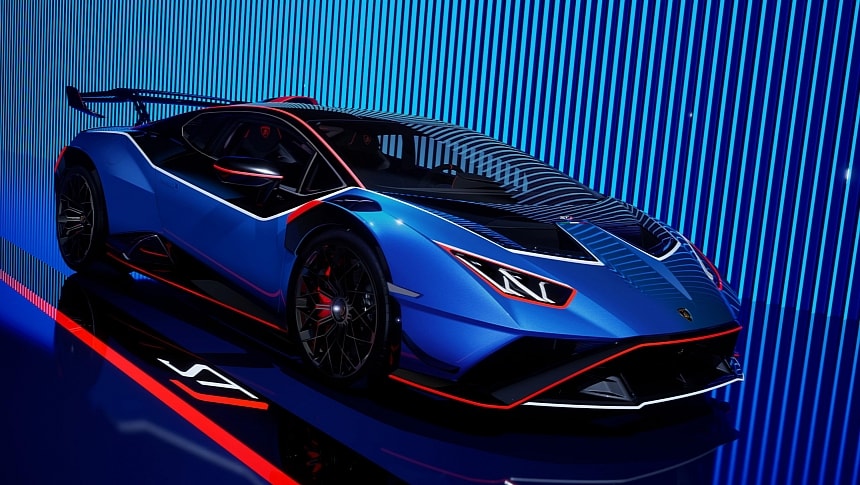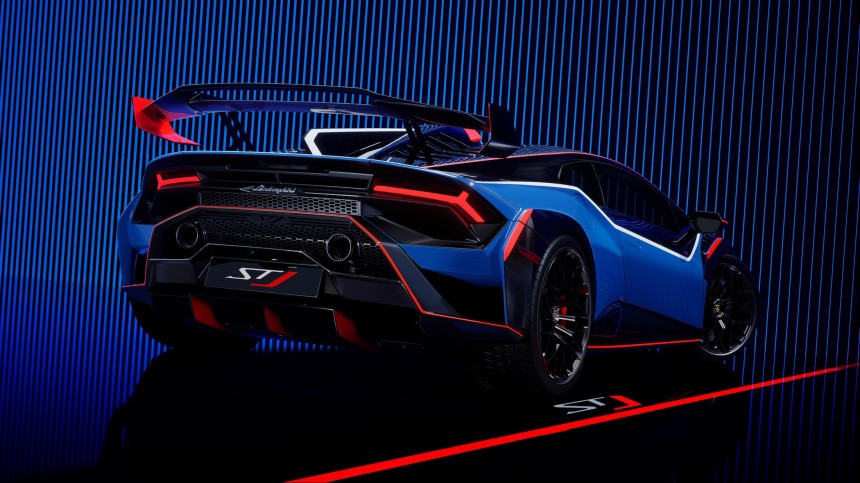Lamborghini is saying goodbye to the legendary V10 engine with a limited edition of the Huracan. The all-new Huracan STJ will only be available to select customers. The model breaks cover just two months after the news of Lamborghini trademarking the "STJ" designation came out.
The Italian house will only build 10 such examples that will be the swan song of the naturally aspirated V10 engine, an icon in the history of the brand.
The engine debuted in 2003 with the Gallardo. It has been powering the Huracan since day one, when it was unveiled at the Geneva Motor Show in 2014.
The Huracan has its days numbered as Lamborghini will replace it before by the end of the year with an all-new super sports car. The automaker is now downsizing, going for a V8 in combination with an electric motor.
The all-new Huracan STJ is based on the Huracan STO, which is powered by the most powerful variant of the V10. It pumps out 631 horsepower (640 metric horsepower) and 417 pound-feet (565 Newton meters) of torque.
The “STJ” lettering stands for Super Trofeo Jota and was previously reserved for the models involved in motor racing. The ST (Super Trofeo) is a tribute to the Lamborghini one-make championship from 2009. Meanwhile, Jota is a reference to Appendix J of the FIA Regulations, establishing the racing car specifications.
The first model to get the Jota specification was the Miura SVJ, developed by the famed test driver and automotive engineer Bob Wallace in 1970. Just one model was made. The car crashed at high speed and burned in 1971.
Now, the Huracan STJ comes with a sophisticated aerodynamic package developed by experts from Lamborghini Squdra Corse. The model receives the iconic “cofango.” This is how the Italians refer to the two carbon fiber aerodynamic appendages or flics.
The aerodynamics experts also increased the angle of the rear wing by 3 degrees. This provides 10 percent more aerodynamic load and keeps the balance properly.
The engine of the STJ comes with the same specification as in the STO. A seven-speed dual-clutch transmission steers 631 horsepower (640 metric horsepower) and 417 pound-feet (565 Newton meters) to the rear wheels.
Four-way adjustable racing-derived shock absorbers increase the mechanical grip. The STJ rides on 20-inch single-nut wheels with Bridgestone Race tires specially developed for this version.
All the upgrades make the Huracan STJ faster by more than one second than the Huracan STO on the Nardo Technical Center Handling Track.
Lamborghini also prepared two different configuration and livery options, both designed by the Centro Stile. One combines Grigio Telesto (gray) bodywork with a Nero Noctis (black) roof and Rosso Mars (red) and Bianco Insi (white) details. The cabin of this version features Nero Cosmus (black) Alcantara seats with leather details and contrasting Rosso Alala (red) stitching.
Meanwhile the second configuration sports a Blu Eliadi (blue) bodywork and a Nero Noctis (black), with Rosso Mars (red) and Bianco (white) details.
A special numbered carbon fiber plate reading “1 of 10” indicates that it is a limited-run version of the Hurcan. There is no word on the pricing just yet, but we should expect it as a more expensive variant of the STO. The Huracan STO arrived in the United States starting at $327,838. And that was before taxes and delivery fee.
The engine debuted in 2003 with the Gallardo. It has been powering the Huracan since day one, when it was unveiled at the Geneva Motor Show in 2014.
The Huracan has its days numbered as Lamborghini will replace it before by the end of the year with an all-new super sports car. The automaker is now downsizing, going for a V8 in combination with an electric motor.
The all-new Huracan STJ is based on the Huracan STO, which is powered by the most powerful variant of the V10. It pumps out 631 horsepower (640 metric horsepower) and 417 pound-feet (565 Newton meters) of torque.
The “STJ” lettering stands for Super Trofeo Jota and was previously reserved for the models involved in motor racing. The ST (Super Trofeo) is a tribute to the Lamborghini one-make championship from 2009. Meanwhile, Jota is a reference to Appendix J of the FIA Regulations, establishing the racing car specifications.
Now, the Huracan STJ comes with a sophisticated aerodynamic package developed by experts from Lamborghini Squdra Corse. The model receives the iconic “cofango.” This is how the Italians refer to the two carbon fiber aerodynamic appendages or flics.
The aerodynamics experts also increased the angle of the rear wing by 3 degrees. This provides 10 percent more aerodynamic load and keeps the balance properly.
The engine of the STJ comes with the same specification as in the STO. A seven-speed dual-clutch transmission steers 631 horsepower (640 metric horsepower) and 417 pound-feet (565 Newton meters) to the rear wheels.
Four-way adjustable racing-derived shock absorbers increase the mechanical grip. The STJ rides on 20-inch single-nut wheels with Bridgestone Race tires specially developed for this version.
All the upgrades make the Huracan STJ faster by more than one second than the Huracan STO on the Nardo Technical Center Handling Track.
Lamborghini also prepared two different configuration and livery options, both designed by the Centro Stile. One combines Grigio Telesto (gray) bodywork with a Nero Noctis (black) roof and Rosso Mars (red) and Bianco Insi (white) details. The cabin of this version features Nero Cosmus (black) Alcantara seats with leather details and contrasting Rosso Alala (red) stitching.
Meanwhile the second configuration sports a Blu Eliadi (blue) bodywork and a Nero Noctis (black), with Rosso Mars (red) and Bianco (white) details.
A special numbered carbon fiber plate reading “1 of 10” indicates that it is a limited-run version of the Hurcan. There is no word on the pricing just yet, but we should expect it as a more expensive variant of the STO. The Huracan STO arrived in the United States starting at $327,838. And that was before taxes and delivery fee.






